
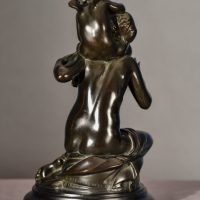
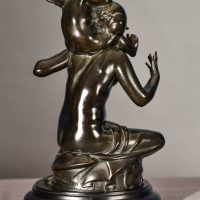



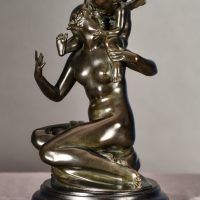
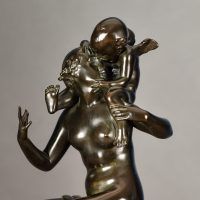

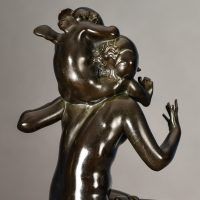
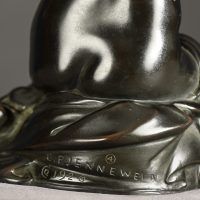
Carl Paul Jennewein
American 1890–1978
Cupid and Psyche, 1926
Bronze, matte black patina
12 ¼ H. x 8 W. x 6 ½ D. inches.
Signed on Base: C.P. Jennewein © 1926
Numbered: (4)
Stamped underneath base:
(4) / P.B. &. Co. Munich made in Germany
(Preissmann Bauer & Co. Foundry)

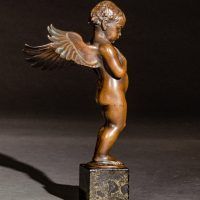

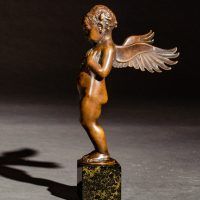

Carl Paul Jennewein
American 1890–1978
Cupid From the Noyes Armillary Sphere
Bronze
6 1/2 H. inches
Munich made in Germany
(Preissmann Bauer & Co. Foundry)

Carl Paul Jennewein
American, 1890-1978
Over The Waves, 1927
Bronze, variegated green patina
48 H. x 31 ¼ W. x 17 ¼ D. inches
Signed on left base: (c) / 1931 / C.P.Jennewein
Stamped on base: Priessman Bauer & Co. Munich
Carl Paul Jennewein
American (1890-1978)
Jennewein received the Prix de Rome in 1916 that bestowed the recipient three years of study and housing at the American Academy in Rome. While in Rome, Jennewein met his future wife Gina Pirra and within a year they had their first son Paolo. Jennewein portrayed his son in a composition placing the child astride a gazelle. He added cherub’s wings and an elaborate saddle fastened around the gazelle’s girth, which in effect elevates the composition to pure caprice. The final product, Cupid and Gazelle was extremely well received after its exhibition at the Academy in Rome in 1920. It received an honorable mention at the Art institute of Chicago in 1921 and a replica was acquired by the Metropolitan Museum of Art in 1922. Ultimately, Jennwein cast thirteen examples produced for sale. Without question the Munich founders, Preissmann, Bauer and Co, completed the finest casts. In fact, the Metropolitan Museum of Art exchanged their 1922 purchase for a cast by the German concern in 1933 at the urging of the artist himself.
Jennewein was born in Stuttgart, Germany, in 1890, one of eight children of Emilia Weber and Louis Jennewein. The father was a die engraver and permitted Paul to watch him work, which soon led to the son developing a love of drawing, engraving and etching. After it became apparent that traditional academics were not a path for the young artist to take, he was apprenticed to artisans at the Stuttgart art museum at age 13. For the next three years, he learned techniques of casting, modeling, and painting. He also took courses in art history and architectural drawing at the University of Stuttgart where he saw illustrations of work by the noted American architectural firm, McKim, Mead & White.
After moving to Hoboken, New Jersey—he became an U.S. citizen in 1915—Jennewein worked for the firm of architectural sculptors and commercial modelers, Buhler and Lauter, which was often used by McKim, Mead & White. Besides working for Buhler and Lauter, Jennewein was also taking night courses at the Art Students League, where he studied with George Bridgman and Dewitt Clinton Peters.(2) By 1911, the ambitious Jennewein struck out on his own, receiving commissions for churches and academic institutions, and after receiving $500 for his work on the Woolworth Building, he had sufficient funds to travel back to Europe for two years.
When Jennewein returned to New York, he received several commissions, including the Caruso Panel for the Metropolitan Opera House. The Metropolitan Museum of Art also purchased his work. In 1933, Jennewein was elected to membership in the prestigious National Academy of Design and the influential Century Club. Other memberships include the National Institute of Arts and Sciences.
Later in his career, Jennewein designed numerous commemorative medals, for which he won many design awards. He died in Larchmont, New York in 1978. In his will over 2000 works were bequeathed to the Tampa Museum of Art.
Source:
The Columbus Museum – Georgia